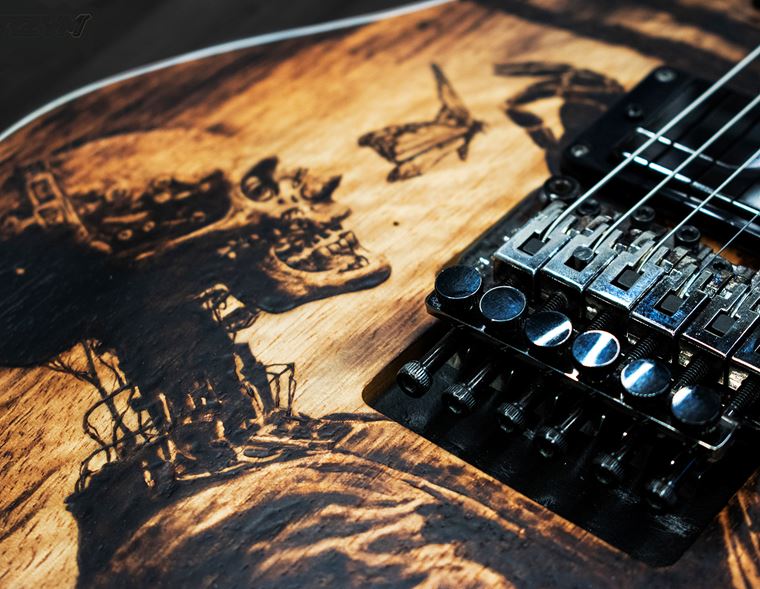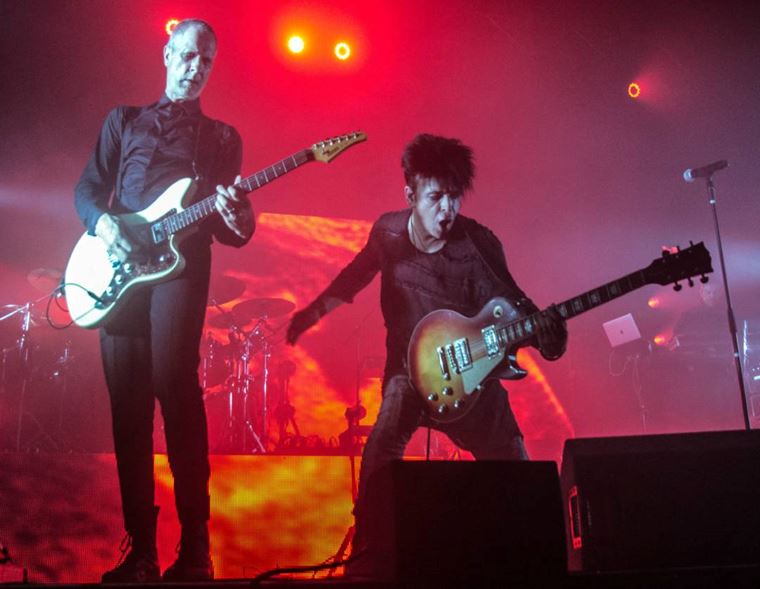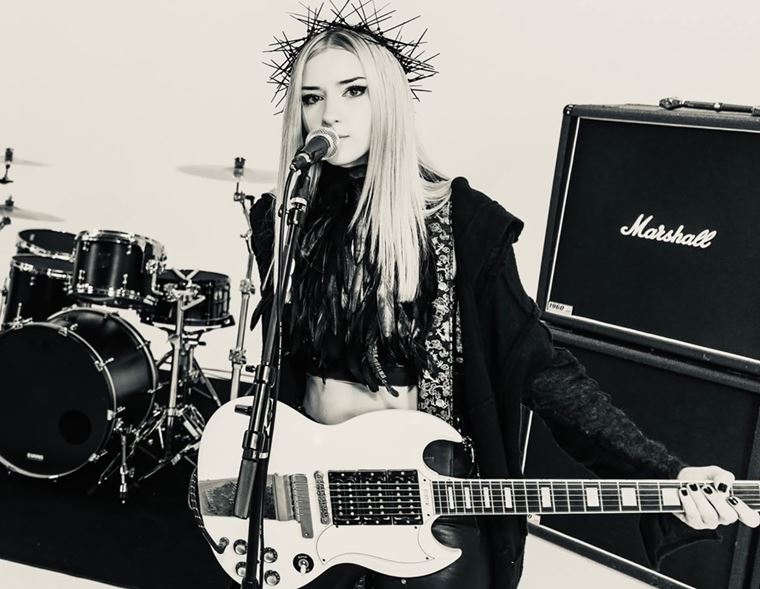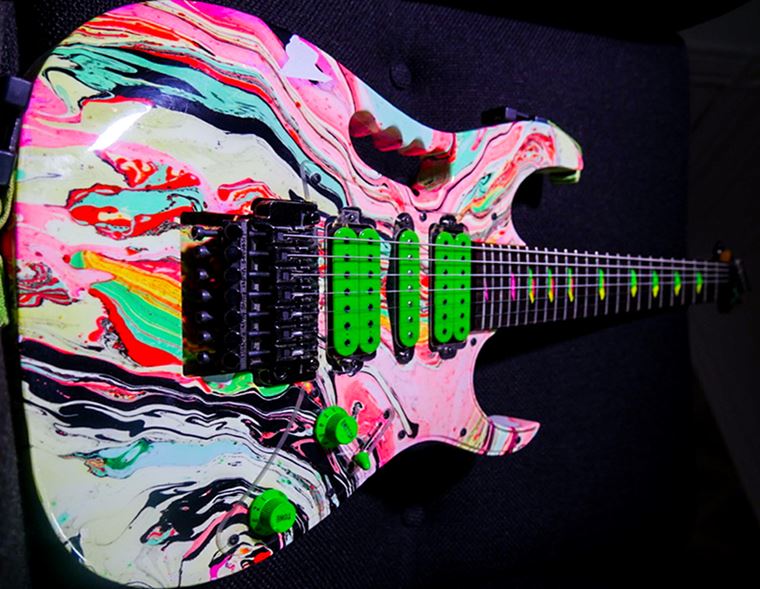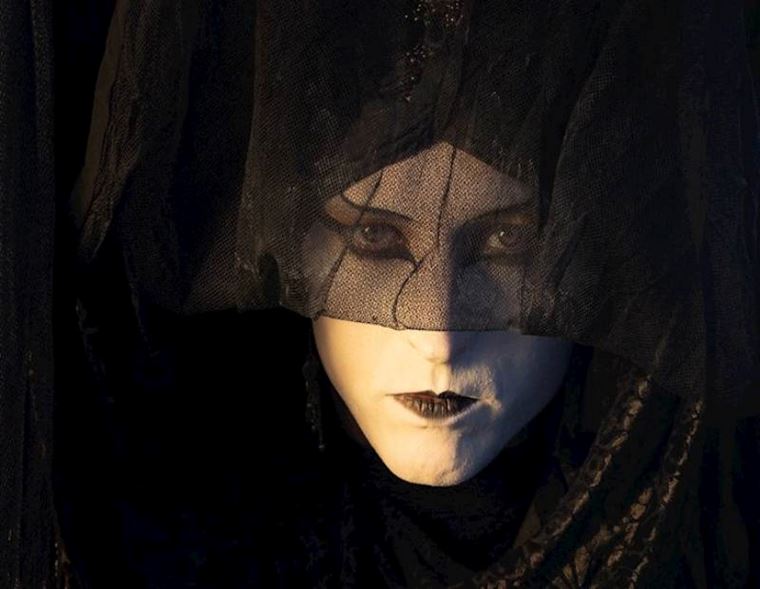"Chris Cornell was a great cat, man. I'd do anything for him": PETE THORN Talks about his New Suhr Guitar, the Classic Rock Show and Loads More!
Pete Thorn is a great guy to talk to. If you’re one of his huge numbers of followers on YouTube then you already know that, of course. Whether checking out a new piece of gear or talking tone and technique, he’s as masterful at communicating as he is with playing music. All one needs is an excuse to start a conversation…
Such an excuse arrived a month or so back, when Suhr guitars finally released their new signature Pete Thorn model guitar. A committed Suhr man (he has signature amplifiers too), his new model is at once familiar and fresh, and we wanted to know more for sure!
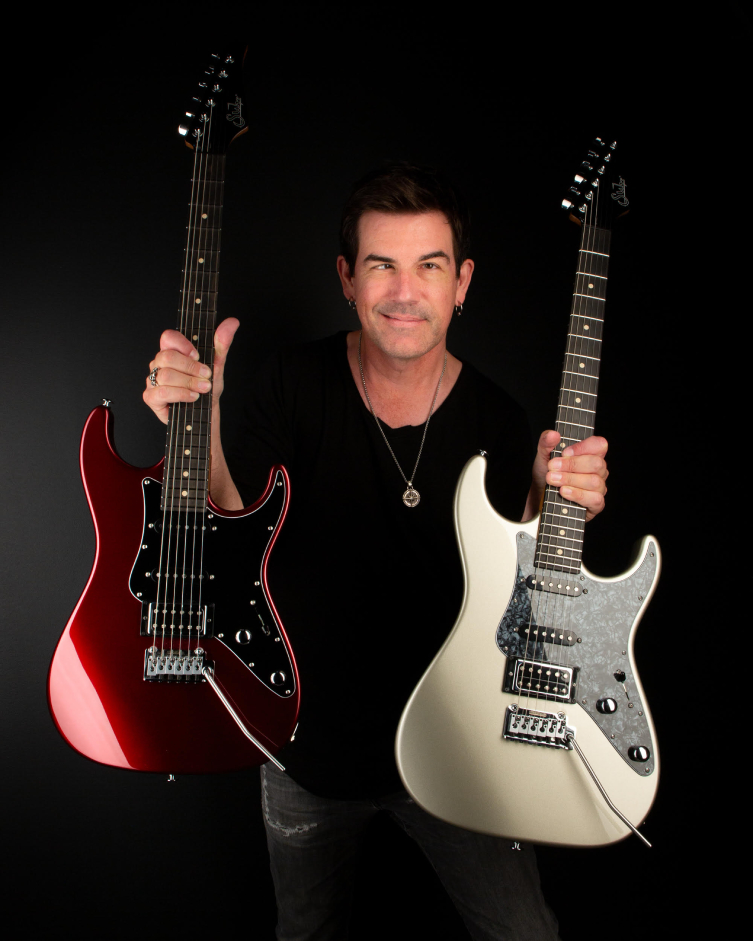
(Photo: Pete Thorn/Suhr Guitars)
But it wasn't just that. I’ve spoken with Pete before, in a three-way conversation with John Suhr, but I’ve never had the opportunity to talk to him about his main job, which is as a guitar-toting sideman to some of the biggest artists on the planet. His globe-trotting career has seen him tour with artists as diverse as Don Henley, Melissa Etheridge and Tsuyoshi Nagabuchi, but it was his four year stint as guitarist - and close friendship with - Soundgarden legend Chris Cornell that I wanted to really hear more about. The rock world still hasn’t gotten over that particular loss, and I wondered how Pete felt about it all from a personal perspective. Would he even want to talk about it?
After finding a time when our schedules allowed it, we arranged a Zoom call and spoke for over an hour about everything mentioned above plus tons more. The Classic Rock Show is coming to the UK early next year, so we covered that. We geek out on Van Halen, discuss the merits of chambered guitar bodies and come clean about those times when it’s okay to change a guitar part as long as nobody notices!
It’s an in-depth interview, and I’ve decided not to edit too much out, because so much of what Pete has to say was just really interesting and relevant. Take ten minutes and join us, two committed guitar geeks, talking about our favourite stuff…
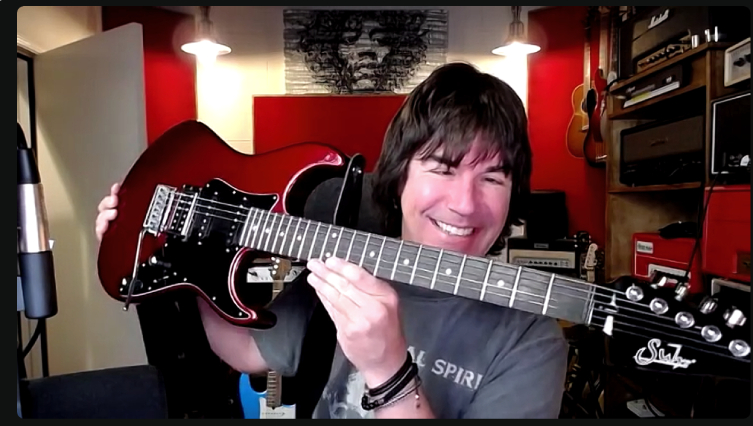
Contents
- Pete Thorn Interview
- Sounds
- Pickups, and an Eddie Van Halen Tone Discussion
- Chambered Bodies: Pete’s Opinion
- Pete’s New Suhr Guitar: Going in Deep
- The Classic Rock Show
- Chris Cornell
Pete Thorn Interview
GG: So this is an HSS this time round. Your previous one was HH?
Pete Thorn: Yeah, my first one was kind of unique. The story behind that one was, I went to Suhr to make a video for the Riot pedal. I didn’t bring a guitar that day, so I said I’d have to borrow something to make the video with. One of the guitars they had in the shop was a limited run they called a ‘Mahogany Deluxe’, which had a flame maple top, mahogany body, mahogany neck, two humbuckers and trem. It was super nice and I thought I would never in a million years dig a mahogany body on a 25.5” scale instrument but I loved it! I spec’d one with a black top, red back, scraped binding and all those woods from that Mahogany Deluxe that I played that day. I just added a couple of features that I wanted, like a series/treble switch and a tone knob etc.
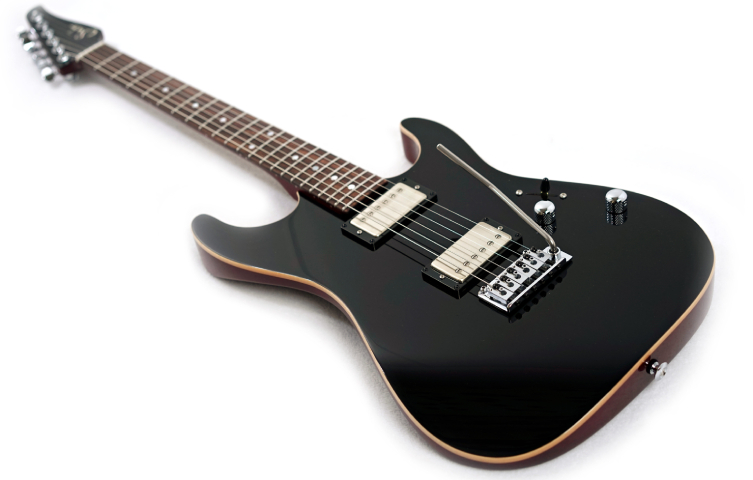
A couple of years later, they came to me and said they were thinking of doing a run of signature models with their artists and would I want to be involved? What would I want to do? I was like, hell yeah! I’d love to do that, why don’t we do this guitar? So that’s how the first signature model came about.
With the second one, I kinda wanted to go with the more typical woods that you would find on a guitar like this, hence: no scraped binding, no maple top; it’s just an alder body, maple neck. It does have an ebony fingerboard and that was purely out of vanity (laughs) because I wanted it to look real dark with the colour choices we had.
GG: It looks really good!
PT: Yeah, I just love all the black pickguard with the black headstock, and then the cool kinda moody colours that we chose. And I wanted to do a true single coil in the neck: I love the tapped single coil sound I can get out of my first signature model, but there’s no substitute, you can’t get exactly the same from a tapped humbucker.
Sounds
And then I was also experimenting with alnico II magnets in humbuckers and wanting to maybe go that route, because I started to realise that with a bright hot plexi kinda sound, it’s nice to sometimes have that balance of a slightly warmer pickup in the bridge position. I was starting to enjoy the sound of an alnico II: the slightly spongier bottom end and that warm top end. I dunno, maybe as I get older I just wanna warm it up a bit (laughs), so that’s how the Thornbucker II came about, the pickup that we developed for this guitar.
So yeah, with the new bridge pickup and the single coil in the neck, there’s some differences, some changes.
GG: Yeah, I did want to ask you about the neck position: true single coil versus the tapped humbucker. What are your thoughts on that comparison? Are there situations where you would still prefer to use the tapped humbucker sound, in a typical gig, over the true single coil?
PT: I think ultimately, in reality, if you like the true single coil sound, you want that vibe. It’s amazing how close you can get with a tapped humbucker, but there are differences in the construction of the pickup, you know, the fact that the magnet in a humbucker is underneath the pole pieces. I think with that difference in construction, it’s never quite the same.
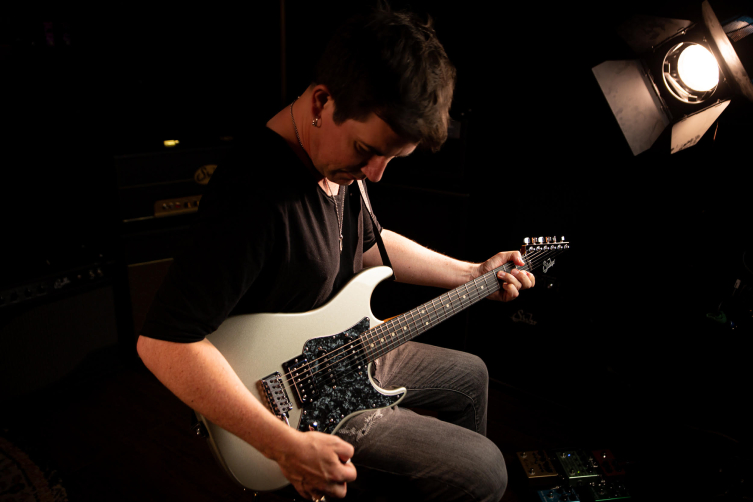
(Photo: Pete Thorn/Suhr Guitars)
I like a neck humbucker that's not more than 8k, generally, that’s hot enough for me. The hotter you go, it changes the resonant peak of the humbucker and it tends to be muddier in the neck position, all that kinda stuff, so I like an almost old-school Gibson T-Top style pickup. Well, when you tap it, now you’ve got something that’s 4k, a really low output pickup, so there’s that aspect. Tapped can be great though, and I was surprised by how good the humbucker sounds when tapped in the neck: I used it all the time, so much that my first signature guitar had that single coil sound as position 5 on the selector. It’s easy to de-mod, by the way, if people have my signature guitar and don’t like that: it’s a one wire thing! (laughs)
GG: Also, this time round on the new signature guitar, you’re using this new Thornbucker, which has an alnico II magnet. Presumably there’s less output with this pickup than with the likes of an alnico IV or V humbucker?
PT: I would say that’s generally true, yeah, and that’s why we actually went and wound it up to 9k.
GG: Ah, cool!
PT: It’s a hotter wind: there’s more turns to compensate for the different magnet. The original alnico IV Thornbucker - and once again, John (Suhr) would say that DC resistance isn’t a total indicator of output, and I’m not as technical as he is so I don’t understand the ins and outs of it - but anyway, having said that (laughs), the original Thornbuckers are about 8.4k.
GG: So, for context, the likes of a Seymour Duncan JB or Black Winter are around 16k or thereabouts, so you're still operating in a sort of PAF/vintage area, output wise. Would that be correct?
PT: Yes, that’s kinda what I dig. I do appreciate some of the hotter pickups when I have them in some of my guitars. But it’s a different sound. I really love old single coils: I love the clarity from Strat pickups. A hot pickup like a JB has a really healthy upper mid resonant peak thing going on, and that’s what people like about them: they’ve got this thing that’ll drive the front end of a dirty amp and really sting in the midrange. It’s almost like having a mid boost on your guitar, but it is a lot of mids! But if you want a lower gain Jimmy Page thing, it’s not the right pickup!
Pickups, and an Eddie Van Halen Tone Discussion
Or even an Eddie Van Halen thing, well, maybe a later Eddie Van Halen thing! I tend to think he was maybe experimenting with the JB around the time of Far Warning.
GG: Oh, interesting!
PT: Yeah, I have a lot of talks with Dave Friedman about this and there’s, y’know, evidence that the pickup that came out of the 5150 guitar that they were measuring for his first Music Man model, that was a JB that they pulled out of the guitar. It was a broken JB, it had a broken coil. This is documented: there’s a great article that Steve and Larry DiMarzio put up about that. We know he used a JB at some point, and I tend to think it was around Fair Warning, right before he went to Kramer. Dave and I think the Unchained guitar tone is a JB. It’s a little darker and warmer. But anyway, I digress! If we were talking about Van Halen, I’d say compare Van Halen II to Fair Warning, and those two different guitar sounds? That’s PAF versus a hotter pickup, to me.
GG: That’s interesting!
PT: My philosophy was always that when amps had more gain, later on, y’know, more gain stages, if you paint yourself into the corner with a hot pickup, there’s no going back. You can’t make a JB sound like a PAF, but you can take a PAF and add something like a Suhr Koko Boost to it and now you’ve got a very similar sound. If it’s coming out of the guitar then there ain’t no going back, and there’s other ways to get gain. So that was always my philosophy with the stringy, single coil thing. I love the clarity with the pickups, with real definition, but I still love a humbucker.
"John Mayer hit me up after he saw my new guitar on Instagram and said, 'You know, man, it's a hard, hard thing to come up with something unique for this style of guitar. Hats off to you, man. You guys really made something beautiful."
GG: There’s so many interesting points there that you raised, and yeah, I would totally say that the Fair Warning sound is the one for me: that’s when I went ‘Holy shit, this is where electric guitar sounds go when they die’.
PT: Haha, yeah! I love it too.
GG: I was thinking then: when it comes to amps, I can see behind you that you have the absolute champagne of guitar amps - as I’d expect from you - are you more inclined to let the amp do the work, so to speak? You just mentioned modern high gain amps, and ever since Randall Smith decided that cascading gain was a thing, we’ve got that on tap, it’s almost like the guitar doesn’t have to do that job at all!
PT: Yeah, precisely. You can get a real pure tone out of your guitar and a pure tone outta your pickups with a little less gain and a little less of a midrange bomb coming out of the pickup, you know? More clarity and than kinda thing. Then there’s always ways to add more gain from the amp or pedals.
GG: Pepper it to taste, right?
PT: Yeah, I mean, when you wind a pickup, what you’re doing is you're kinda closing down the top end and you're getting this sort of resonant peak that is moving lower. When that happens, that can move down into the upper mids and that’s what gives you that JB thing, wherever the resonant peak is on that pickup. I’d guess it’s 2k or 3k, somewhere that’s almost like a midrange push. But then when you clean up the amp and stuff, it’s not gonna get sparkly and real clean because you’ve got this thing pushing into the front end of the amplifier. It’s an interesting phenomenon and I had the great luthier Gil Yaron make me a ‘59 Les Paul repro kinda instrument, and he asked me did I want it to be a rock thing - midrange- or did I want it to do the Jimmy Page thing: be a little more like a Tele on steroids. I said no, no, I want the Tele on steroids thing! I want the clarity, and all of those options. That’s kinda where I’m at. For the last ten years or so, that’s been my path: that’s the way to go with pickups and stuff.
Chambered Bodies: Pete’s Opinion
GG: I wonder, just as a bit of an aside, but since we’re talking, I’d love to have your opinion on it. So the likes of single cut guitars with chambered bodies: have you had much experience with those? And do you notice a difference between one of those and one that’s just fully mahogany with no chambers?
PT: That’s a really funny question! That’s a great question, because my first signature model guitar actually has some chambers in it.
GG: Oh, really? I didn’t realise!
PT: I know, I didn’t know either! (laughs) Whatever they did when they made the Mahogany Deluxe, it was like “that’s what I want: I want that thing!” So they made it for me, and the guitar’s a reasonable weight. The thing is, mahogany can be heavy. I got these signature models, which were somewhat chambered and I didn’t even know that. At some point, I don’t even remember how it came up, but they went “Oh, those guitars are chambered! We chambered them”, and I was like, “Oh!” Hahahaha! It was something we’d never discussed but it goes back to the original order. I never thought about it and the guitars sound great so I was always happy with them, so it was never a big deal to me.
"I can't show up with a hot pink guitar if I was playing a show with Don Henley or something, you know?"
Okay, so on a singlecut guitar that you want to be as close as possible to the ‘59 Gibson, you probably don’t want it to be chambered because you’re going for this thing. It’s not about the ‘best way’, necessarily, but it’s about having it how it was in 1959, an exact reproduction. And that’s what you’re gonna get if you get one of those Murphy Lab Les Pauls from Gibson, and that’s probably what the customers want, for the most part. So, now, if you get a modern Les Paul that’s not necessarily about being that spec or anything, you might go “Yeah, I want it to weigh 8 lbs because I play a lot of gigs!” It’s a different thing, it just depends on what you want. If you absolutely don’t want chambers, then you gotta find some nice, light mahogany.
We can get geeky about whether a guitar’s chambered or not, we can get geeky about all kinds of things, but you know, at the end of the day, when I got my signature guitar, and it was chambered and I didn’t even know it, and I played it for a while like that: had I been asked before ‘do you want it chambered’, I’d have said, ‘no, way!’ (laughs) Know what I mean? It made me think, well, there’s nothing wrong with it, if you’re getting a good result out of it at the end of the day.
So, I dunno if that is kind of a non-answer! I think at the end of the day, if a guitar is good and it speaks to you, and if the tone is good and everything, then what’s the difference?
GG: Yes indeed, it kind of puts into perspective specs versus the actual jobs that these instruments are tasked with. Although it’s another tangent, I thought just there about the famous Greeny Les Paul, the ‘59 model owned by Peter Green, Gary Moore and now Kirk Hammett. When Kirk’s playing Metallica songs, it sounds like Metallica.
PT: Yeah, yeah, totally.
GG: It’s kind of like, at what point does the guitar become less of a factor in the overall sound, but maybe we don’t want to focus so much on that since we’re talking about your new guitar? (laughs)
Pete’s New Suhr Guitar: Going in Deep
PT: Well, it’s okay actually because here’s the thing behind my guitar. I always say that most artists that have signature models - let’s take Steve Vai or John Petrucci - those guys are - and rightfully so - stylists that exist in their own universe. Steve Vai is Steve Vai and Petrucci is Petrucci: they are their own category of guitar music, basically, when we think about it, right? So they have signature instruments that kind of reflect that. They are very personalised: Steve’s guitars can have all the crazy stuff like vines down the neck, or he’s got the monkey grip, stuff like that, right? That’s what sets him apart: he’s a stylist and he can do all these crazy things to have an instrument with all these unique features to set it apart.
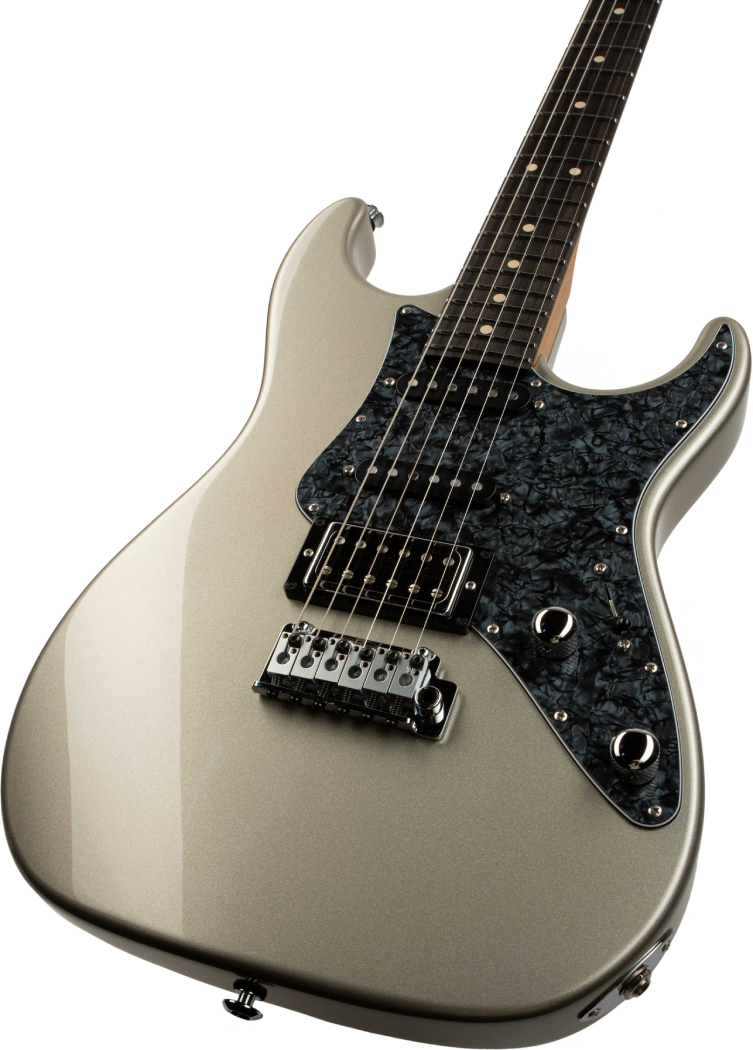
I exist in kind of a different world, where I’m mainly known as a touring sideman. And a guy from Youtube. But the touring sideman thing is where I came from: a bit of a jack-of-all-trades, and having to morph into different situations. I’m a little more akin to a working player that does different styles of gigs, so with my gear, it’s gonna reflect that. It’s gonna be a tool where, hopefully, if you can only bring one guitar to a gig, it’ll be able to cover most or all of the bases, you know? And also a look that works in a number of different situations. I can’t show up with a hot pink guitar if I was playing a show with Don Henley or something, you know? (laughs) ‘Get that thing outta here! Where’s your Telecaster!’ Haha, so I have to be careful sometimes. I try to make guitars that have features that are gonna appeal to a wide range of working players, that really need an instrument they can fall back on. One minute playing rock, the next minute playing country and stuff, and it stays in tune and is really versatile, and also will have a look and an aesthetic that just fits in.
"My guitar is gonna be a tool where, hopefully, if you can only bring one guitar to a gig, it'll be able to cover most or all of the bases, you know? And also a look that works in a number of situations."
Yet, I want it to be distinctive, and I want people to know it’s my signature model. On this guitar, we spent a ton of time coming up with this unique pickguard. John and I spent a long time on it and making it flow. He’s great with lines; he’s got such a great eye for the whole instrument and the way everything flows.
The reason we did the guitar with no pickup ring is, my other guitar has pickup rings. I had to talk them into it: they didn’t wanna do it initially and I said ‘It looks cool!’ It’s the one thing, otherwise it looks like a Suhr Standard. These little visual things can set my guitar apart. So this one (the new model) was originally a direct mounted pickup and there wasn’t enough going on in that part of the guitar. I said ‘let’s try a ring’ - had to talk them into it again - and then we tried a covered humbucker, open coil, the whole thing, and it was actually John’s idea to go, ‘What about a window cover?’ I’m like, ‘what’s a window cover?’ ‘Oh, you know, one of those ones that makes them look a little like a Gretsch Filtertron’. We tried it and I was like, ‘Oh, damn, that’s cool’. So the ring and the chrome, and the pickguard flowing through: all the stuff we spent a lot of time on to give the guitar a visual that’s very distinctive and unique, and I just love it, man!
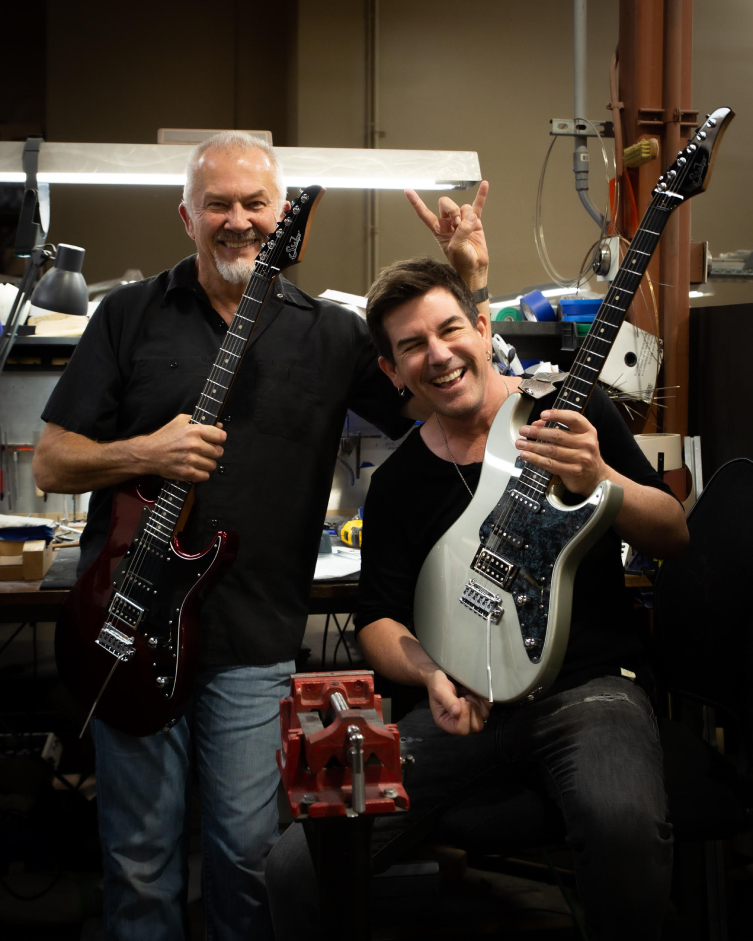
(Photo: Pete Thorn/Suhr Guitars)
John Mayer hit me up after he saw it on Instagram when I first posted it, and said: ‘You know man, it’s a hard, hard thing to come up with something unique for this style of guitar.’ He said ‘Hats off to you, man. You guys really made something beautiful’. That meant a lot to me, because he was really into all that making the Silver Sky, and he’s taken a lot of chances and bold design moves to come up with something unique of his own.
GG: That’s awesome, yeah! Your guitar is stunning, and as you say, it’s not the easiest thing in the world to reimagine the Strat-style guitar in a different context. Especially when your previous Suhr already had its own identity. I didn’t realise it was the pickup rings amongst other things, but yeah, that absolutely puts your head in a different place. You hit on something a minute ago that I’m so glad you brought up, because a lot of people feel it but don’t talk about it. It’s this kind of notion of the appropriateness of a given instrument’s aesthetic, when you’re approaching it as a musician. Somebody like you has played with so many notable people and yeah, you don’t show up to the Don Henley gig with a pink JEM, absolutely, but how about this: you’ve got two relatively distinct signature Suhrs, even though both are S-types. Do you approach each of them with a different ‘playing hat’ on, or a different headspace? LIke, would you play stuff on one that you wouldn’t prefer to play on the other?
PT: Um, you know, it’s interesting people the primary difference between these two guitars in the single coil in the neck. When you really come down to it, that’s the main thing. If I needed a true single coil at the neck, I’d use this new one. The other one, for me, with the mahogany and everything, it’s just a little more ‘Les Paul’, even though it’s not. It’s just got a little bit more of that thing going on. That would be the difference, tonally: I think about it a little more in that range, even though scale length-wise, it’s still 25.5”. That has a huge impact on the tone: they still sound ‘Fendery’, no matter what. That twang, that snap.

(Photo: Pete Thorn/Suhr Guitars)
The neck on the other one is also a little different, I should say. The neck on the other one is the Even-C Slim, which is a standard shape that you can order from Suhr on other models. This new one actually has a new neck shape that is unique to this model. We copied it off an old pre-2010 Suhr Classic that I had, and it’s a slightly wider nut, so a little bit more space between the strings down here, and this neck also has just a little thicker profile. I like a lot of different neck shapes, and I don’t find the Even C Slim neck to even be that slim: it’s just a nice neck. With ‘slim’, I start to think about the Ibanez Wizard back in the day, and it’s not like that at all.
So that was the neck on my original model, but on this one I thought, let’s try something a little different: wider nut, a little bit thicker, and it’s just… nobody’s gonna play this and think it’s small. There’s no way! It’s not that big either, it feels a lot like my ‘64 Strat, actually.
GG: That’s interesting that on this new guitar - and I know I’m pushing them into generalisms of ‘this is the more Stratty one and the other is the more Gibson one’, it’s interesting that you went for the wider nut on the more Fender-spec’d guitar, when you’d typically associate the slightly wider nut with Gibson, right? 43mm over 42-point-something. That’s an interesting difference.
PT: Yeah, and I mean, I debated about it on the other guitar, but I find I can move between the neck shapes without a problem, they’re not that different. And the radius is the same 10-14” compound, so that makes it easy to go between them.
The Classic Rock Show
GG: Awesome! So, I wouldn’t mind asking about the Classic Rock Show?
PT: Of course, yeah!
GG: So, the Classic Rock Show is coming to the UK and Europe next January and February, and one thing that I always wonder about these types of shows is: how do you decide on the setlist? Is there a democratic process, or does somebody say ‘this is what we’re doing’?
PT: No, it’s not a democracy. At the end of the day, James Cole is the musical director. He will make a final determination on what we’re gonna do based on a lot of factors. Having said that, he always asks everybody and takes requests into account. He’s usually quite accommodating about that. But there does have to be somebody deciding, because there’s gonna be songs that some people just don’t like, you know? And others that people feel strongly about. One thing about James, who grew up in the UK: for me, coming from the States, I’ve had to learn that there’s a whole range of songs that will work in the UK that won’t necessarily work over here.
GG: Oh, really?
PT: Sure! Like, last time, we played a Status Quo tune. That’s just not something you would play in the US because they didn’t have the impact that they did in the UK, where it’s going to go over great. So, y’know, Rainbow would be another one: you could play a song like ‘Since You’ve Been Gone’ in the UK and everyone knows it, it’s great. Over here, it’s gonna be like: ‘I think I know that song?’ They just didn’t have the impact. Over in the UK they may have been a full-on arena band, but over here they might have been more like a theatre band.
And vice versa! Coming over to America, he’s said to me many times, ‘If we do some US dates, you’ve gotta help me out the set list together!’ There’s bands like Foreigner, or Journey who were big worldwide, for sure, but they’re just bigger, massive stadium bands in America. So yeah, it can’t be too democratic, but he always asks: he’ll take everyone’s input into account and then make a final decision.
It’s always fun, man. There are absolutely no bad songs in the set, that’s one great thing: you go to a Classic Rock Show, it’s gonna all be great tunes! No filler! Whether each individual one of us loves every song is beside the point, because you look out into the crowd and people are going nuts, having fun.
GG: That’s what it’s all about! I was actually going to ask you, Pete, if there were any songs that you wouldn’t mind seeing dropped from the set list, but I realise that isn’t really the point so I won’t ask you to answer that, haha! But I suppose, do you have any particular favourites that you look forward to playing? And also, even though you’re a wonderful guitarist, you’re just a human like the rest of us: are there songs or parts that you don’t look forward to because they’re difficult to pull off live?
PT: Oh, sure! I mean, it’s like, the first year I did it, I played Eruption. I didn’t actually look forward to doing that every night! (laughs) We did Eruption into Jump, and I love playing Jump, that’s a blast. But the pressure of having to do an Eddie Van Halen guitar solo! But I guess I did it! It’s like, I love slotting into the band and having my role as a sideman, as opposed to being that solo guitarist. I love finding my place in the song.
So yeah, that was one moment. Other than that, there’s not really any others. I mean, it’s always a fun challenge when there’s a tough part coming up. You just gotta concentrate, and that’s what keeps you young or something, you know? Stay focused and dialled, maybe practise it before the gig. I get pretty hard on myself sometimes about playing the parts exactly as they are on the record, and then I realise: nobody cares! There’s nobody in the audience that will notice if you switch it up a little to make it a little more comfortable for yourself. So, I did that this past tour a little bit. I would modify things a little, and what happens is, instantly you sound more comfortable, you’re more in the zone, you’re having a better time, and it comes off better! It’s a win-win for everybody. The pressure I was putting on myself as a player was kind of silly, and I had to realise that.
And the moments that I look forward to in our set? The whole back half of the second set is really rocking, it kinda ramps up with great energy, and the crowd is all on their feet by then and stuff. It’s really fun. During the last tour, we were doing, like, Thunderstruck into Jump, you know, those tunes. Anytime you’re playing AC/DC is a blast!
GG: Awesome! The home stretch! It’s interesting what you said about changing things to make your playing more comfortable, because you reminded me of the last time I spoke to Joe Satriani. He said that quite often with his earlier material, he doesn’t play it anything like how it was originally played on the record, even though the notes remain the same. He’s realised since recording it that he didn’t play it the easiest way at the time.
PT: I’ve seen him do that!
GG: Yeah!
PT: Like Satch Boogie? I swear he plays a few things in different positions than he did when he recorded it, but it’s the same part. It’s really interesting, he’s retrofitted it a little to make more sense.
GG: There you go!
PT: Yeah, why not make it easier if you can? It totally makes sense. I’ve had things where I was sure they were a certain way, like little Eddie Van Halen parts, and then somebody would say ‘no, no, you play it down here!’ I’m like ‘Oh! Discovery!’ You know?
GG: Totally!
PT: I guess if we learn it the wrong way, we can then make our own lick out of it and we come up with our own thing.
"Chris Cornell just had a really big heart. He was a great cat, man. I would do anything for him."
GG: That’s very true! And talking about your own thing: you’ve done two solo albums in the past, so I was wondering if you’re working on anything at the moment?
PT: That’s been my intention, but…I thought maybe I’d have a quiet Fall and then I would go into doing some development for a new album, but what’s actually happened is, I’m going on another tour. I’m gonna tour with Nick Carter.
GG: Oh, nice!
PT: Yeah, that’s happening in October and it’s a lot of songs, it’s gonna be a really fun show. That’s gonna be great but it’s just taken a lot of focus all of a sudden, which I’m happy to do: I’ve met some great new musicians who I haven’t played with before and we’re having a really fun time, but it came out of the blue, so solo album three gets pushed back once again, I guess!
But I gotta go play, I gotta go tour: that’s a big part of who I am.
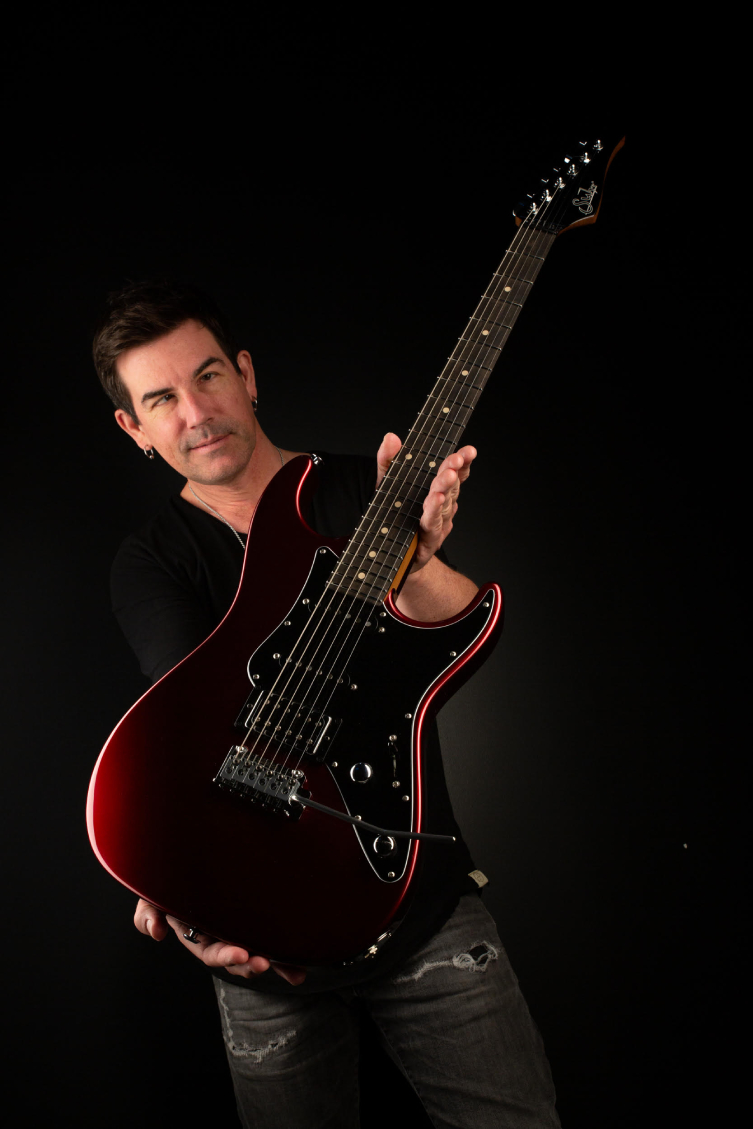
(Photo: Pete Thorn/Suhr Guitars)
Chris Cornell
GG: Hell yeah! And since last time we spoke it was entirely about Suhr, I didn’t have the opportunity to ask you about the various gigs you’ve had over the years. One of the things I always did want to ask you about is: you’ve been the sideman for one of my generation’s greatest singers, the much-missed Chris Cornell. I just wondered if you had any memories, stories or just vibes about what it was like to be with him?
PT: He was such a special guy, man. In many ways, that gig was the perfect gig because musically it just fitted in with what I love, and it felt so satisfying on a soul level playing that music, even though it’s not my music. I just loved playing that rock music with that guy singing. I had to pinch myself every night.
He was a very funny guy, he had a great sense of humour. He was a deep guy. When I went to his service when he’d passed away, that was what really hammered it home, when you say how many people he was involved with in his life that he could call friends and colleagues. Everybody that was there - people from the music industry of course: Metallica was there, Alice in Chains was there, all these types of folks - but there was also all these folks because of his family, his wife, the Greek community; all these folks from the film community because of his involvement in things like the film The Promise that he did just before he passed. There were a lot of people that that guy touched, that really cared about him.
It was so fascinating, because by that same token, he made you feel like… it’s a special thing that some people have when they can have a very broad, busy life with many people involved, but when they’re hanging with you, you feel like they really connect and are focussed on you. You don’t feel unimportant, you know what I mean? He had that way about him. He had his two feet on the ground, and he was definitely a rock star, but I think sometimes when stardom and success comes to people a little bit later, and not too early when they’re too young, he really appreciated the value of a dollar, for instance. And he really appreciated everybody’s effort, no matter what they were doing in the organisation. He was a salt-of-the-earth kinda guy, I don’t know how else to put it. A really, really good person at the end of the day, with his heart in the right place. He was always involved with good charitable causes, and I considered a really, really good friend.
After my time touring with him - which spanned 2007 to 2010, over 300 shows all over the world - after that, he did the Songbook tour, which was acoustic guitar solo, and then Soundgarden again. At that point, I knew, like ‘Ok, there’s probably not gonna be any more solo touring at this point’, I did end up playing a few more shows with him which was brilliant, and I’m really glad I had those opportunities in 2016, but we always stayed in touch during that time, and I wasn’t working for him or anything. We’d both geek out on guitars as well as studio stuff. He loved the process of home recording and he trusted me to help him out in that department, like for instance, setting up his computer with software for Logic and drum programming, selecting equipment for his home studio, things like that.
So, I’d always be there and help him with those things, and I really enjoyed that, because you know me, I love geeking out on gear and stuff!
GG: Of course!
PT: And so, we would have great discussions about that stuff, just as any two musicians would do. ‘What do you think about this mic pre?’, things like that. Anyway, he called me one day in probably 2012 or 2013, and he said ‘Hey, what are you doing?’ I said, ‘I’m just in my studio, just working’, this is when I had a studio in Santa Monica. He was like ‘Have you got time today? Can you stop by?’ He didn’t live that far away in LA, kinda central. I said sure and he was like ‘come by, I got something here I gotta show ya’. Okay, so I drove over and pulled up half an hour later.
He was outside, I always remember, playing basketball with his son in front of the house. He saw me pull up and he goes ‘Just a second!’ and runs in the house. He comes back out with a guitar case and he hands it to me and goes, ‘Here, it’s for you’. And it was a Martin D-28, a beautiful D-28.
GG: Oh wow!
PT: I had mentioned to him maybe two years prior to that. He was really in with Martin and I said, ‘I gotta get a D-28 one of these days. Can you hook me up with your guy at Martin so I can talk to him?’ He said ‘sure’ and gave me somebody’s email. I kind of never did anything about it after that, didn’t really pursue it. But he hands me this D-28, and he got it for me and was like, ‘Here, it’s for you’. I still get…it’s one of the nicest things anybody’s ever given me.
GG: That’s incredible.
PT: Yeah, and he was kinda shy about it, but I always remember him saying ‘You’re always there for me whenever I need something, I just wanna give you this’. And I was just like (shakes head) 'Goddammit’, you know?
GG: That’s awesome!
PT: Yeah, so he just had a really big heart. He was a great cat, man.
GG: That’s so good to hear.
PT: Yeah, and so I would do anything for him. So, on the last Soundgarden tour, he wanted to make a switch with amps, so I got him all set up with some PT100s and was really enjoying talking to him about the whole process of how he was using them and integrating them. He actually took one of my heads and he had one as well, and he had two of the signature 212s, and I just loved hearing about his rig, getting this sound and that sound, and having some email exchanges and stuff. And then not long after that was when he passed away, and it was so, like… I remember that juxtaposition: he was having an issue that week with MIDI. The amp switches via MIDI and one of them wasn’t switching and he couldn’t figure out why. Turned out he was using a faulty cable! We were tearing our hair out.
This was on Monday of the week when the unthinkable happened. We figured out the issue, and I was feeling so frustrated about it, and two days later he was gone, you know? That was a real, like, on a Monday I was trying to figure out what was going on with the rig, and then on Wednesday, your whole world gets turned upside down. You’re like, ‘Oh my God, can we just rewind 48 hours?’ It was the weirdest feeling, because I was stressed out about that, this silly thing about gear and stuff, and I just wanted to rewind back to where I was caught up in this silly thing, and now it means nothing, you know? It’s so weird. It’s a strange thing in life.
His death, I think for a lot of people, still feels like ‘I can’t believe it, I still can’t believe that guy’s gone’, and I feel that way too. It doesn’t make sense to a lot of us, both fans and those who knew him. There’s this collective kind of…’it doesn’t add up’ thing. There’s a lot of conspiracy BS out there and I don’t buy into any of that garbage, but that’s not what I'm saying. It’s more about how life can smack you in the way sometimes. That’s one of them. You just want the guy to be around so bad.
But anyways, that’s my experience with him. Life’s short, I guess, and you just gotta be present. That’s one thing I can say: I wish I’d been more present, sometimes. I’ll see videos on YouTube of us playing a gig, and I’m like, ‘Well that’s me, but I don’t really remember that exact show’. I mean, it’s a whirlwind when you’re out there playing five shows a week or whatever, different time zones and stuff: you’re on autopilot a little bit. If anybody’s out there and they get a good gig and are touring, try and be really present because it’s gonna end at some point and all you’ve got are your memories. You’re gonna want to remember where you were, and the great things, how fun it was.
I’ll share one last thing, I know I’m rambling! In 2014 or 2015, I remember emailing him. I’d gotten to Kojima, Japan, and was playing with the great rock artist Tsuyochi Nagabuchi and I was back and forth from Japan four times in the first six months. We did a full tour then some one-offs, then another one-off. A lot of jet lag! So, it was my third trip there in 2015, I emailed him and said, ‘Man, I’m in Kagoshima, and I don’t even know which end is up! (laughs) I’m feeling frazzled! And he said something along the lines of like, ‘Just try to get some rest and stock stock: try to enjoy this crazy unique life that we get to live’. You know? It was like, that’s him: a glass is half-full guy, right there. And I had to go, ‘crazy, unique: it is! I’m in Kagoshima, there’s a volcano over there across from my hotel! I can see it, it’s amazing!’ (laughs)
GG: What an insight, haha! That’s awesome! Aw Pete, thank you for sharing all that stuff. Now, I’d normally round off an interview like this by asking what you’re up to next, but we’ve already spoken about Nick Carter and the Classic Rock Show tour: is there anything else that’s coming up?
PT: Well, one of the things is that we’re working on some new stuff at Suhr. While I can’t go totally into details, we’ve been working on a different amp for a long time. So that’ll be coming , and I’m enjoying that process. Things always take time, but it’s gonna be really cool, so it’ll be the next kind of evolution of what we’ve done with the PT100 and PT15. My goal is just to have it be amazing for people, all the way from the Fendery clean thing through to the modded high gain stuff, so it’s gonna have more voicing and more options actually, whilst still being very simple and easier to use than anything we’ve done before. Some folks who live in the mid-gain world, plexi, lower gain kinda stuff: I wanna make them really happy with this new thing we’re doing. Including myself! There’s a selfish perspective! If you love the Suhr SL67 amp, that kinda thing, I want to basically nail that thing on this amp. Also, we’re talking about some even higher gain stuff, for folks who want that direction. It’s still a three-channel situation, but you’re gonna be able to voice all three in a simple but a really effective way. So I’m really excited about that. I can’t say when, but next year. Whether that’s January or whether that’s June, I don’t know, but it’ll be really cool.
GG: It’ll take as long as it takes.
PT: It’ll take as long as it takes and then it’ll be great.
I have no doubt about it! Pete’s a great conversationalist, and I felt privileged that he decided to share so many touching moments about his dearly-departed, exceptional friend.
There were lots of cool anecdotes in there for classic rock fans and Suhr acolytes, too!
The new Suhr Pete Thorn Signature guitar is exceptional, so make sure you investigate further next time you visit us. In the meantime, keep an eye out for Pete’s comings and goings via the official Pete Thorn website, and head over to the Classic Rock Show website for next January/February’s UK and Europe tour.
I’d like to thank Pete for not only finding time to chat but for sharing so many insights, thoughts and precious memories. After all, that’s what it’s all about.
Until next time!



